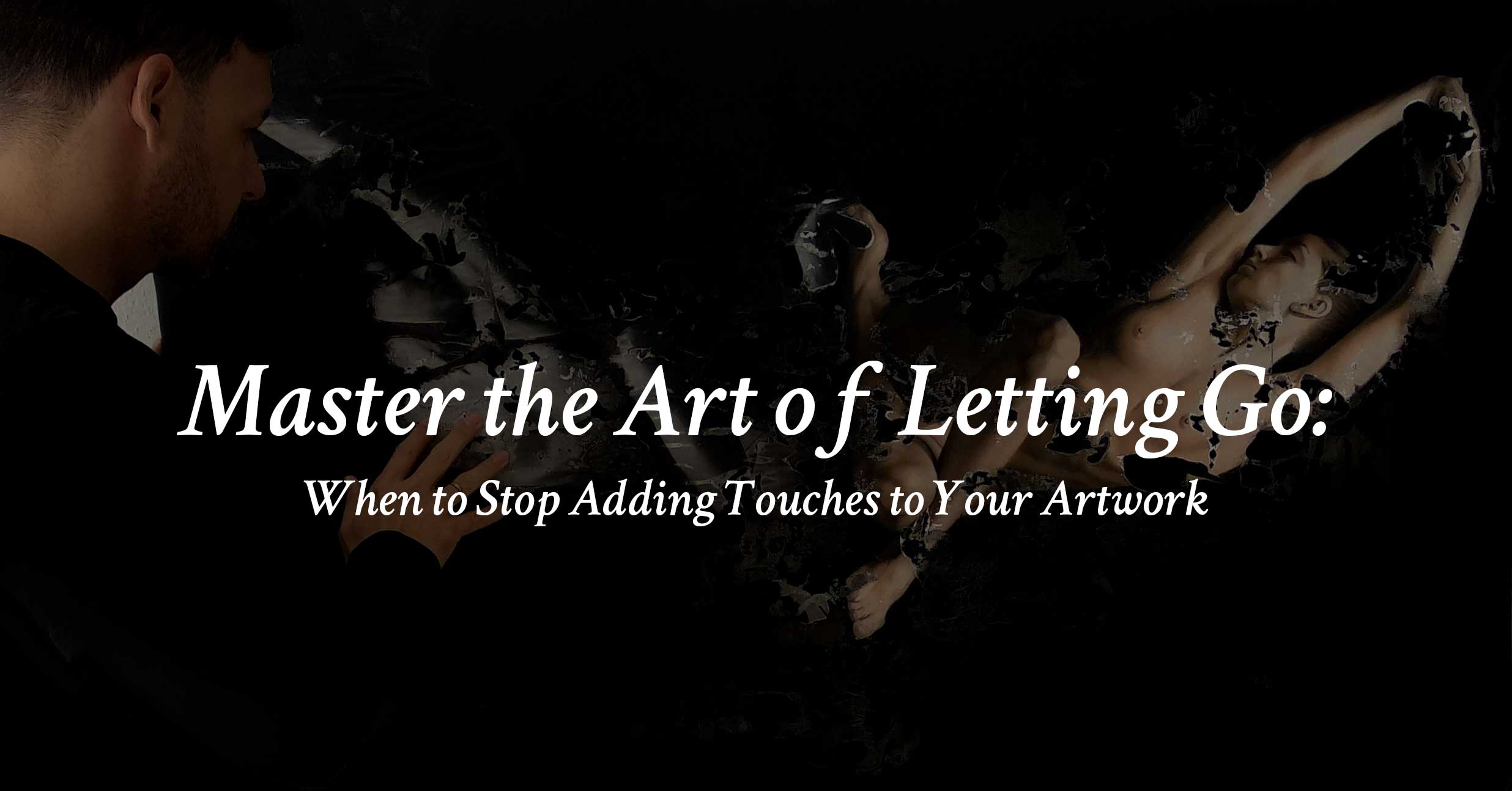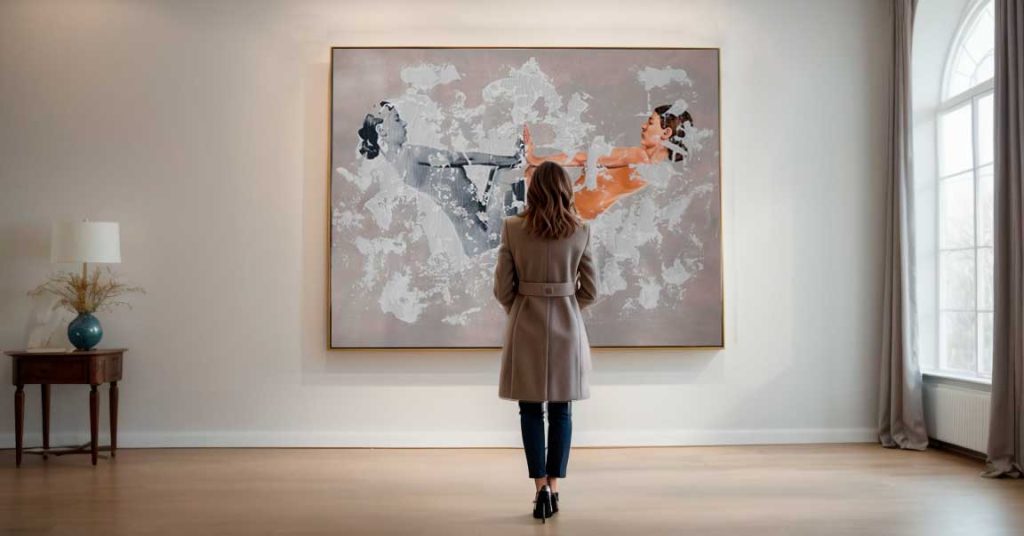
The Art of Letting Go: A Paradoxical Skill Every Artist Needs
As an artist, you know how hard it is to let go of your work. You always feel like there is something more you can do, something better you can achieve, something closer to your vision you can create. You keep adding touches, tweaking details, refining colors, until you are satisfied with your masterpiece. Or are you?
Mastering the art of letting go is a paradoxical skill essential for every artist. It entails recognizing the moment to conclude work on a piece and embracing it in its current form. It involves acknowledging “this is enough” and transitioning to the next project, appreciating the work for what it is rather than what it could become.
Why is this skill so important? Because letting go has a huge impact on the quality and value of your final piece. If you overwork your piece, you risk losing the freshness, spontaneity, and originality that made it unique in the first place. You risk muddying the composition, dulling the colors, and flattening the perspective. You risk making your piece look overdone, forced, and lifeless.
On the other hand, if you let go of your piece at the right moment, you preserve the essence, the energy, and the emotion that you poured into it. You enhance the clarity, the harmony, and the balance of your piece. You make your piece look natural, effortless, and alive.
But how do you know when to let go? How do you overcome the urge to keep working on your piece until it is perfect? How do you deal with the fear of failure, the doubt, and the insecurity that keep you from finishing your piece? Here are some practical techniques that can help you master the art of letting go.
The Struggle is Real: Why Overworking Happens
Before we dive into the techniques, let’s understand why overworking happens in the first place. What are the common reasons why artists struggle to let go of their pieces?
Perfectionism
One of the main reasons is perfectionism. Perfectionism is the belief that your work has to meet some unrealistic and unattainable standards of excellence. Perfectionists are never satisfied with their work, no matter how good it is. Artists always find flaws, mistakes, and shortcomings in their pieces. They always compare their work to others and feel inadequate, another common thing is that artists allways think that their work could be better, if only they did this or that.
Fear of Failure
Another reason is fear of failure. Fear of failure is the anxiety that your work will not meet your own or others’ expectations. Fear of failure makes you doubt your abilities, your choices, and your results. It makes you worry about the outcome, the feedback, and the criticism that your work will receive. It makes you avoid finishing your piece, because you are afraid of being judged, rejected, or ridiculed.
Attachment
A third reason is attachment. Attachment is the emotional bond that you form with your work. Attachment makes you feel proud, happy, and fulfilled by your work. It also makes you feel protective, possessive, and defensive of your work. It makes you reluctant to let go of your piece, because you feel like you are losing a part of yourself, your identity, or your expression.
These are some of the common reasons why artists overwork their pieces. They are not necessarily bad or wrong, but they can become harmful and counterproductive if they prevent you from letting go. They can also affect your mental and physical health, your creativity, and your productivity. That’s why you need to learn how to overcome them and let go of your piece when it is time.
Art of Letting Go in Action: Practical Techniques


Here are some actionable tips that can help you recognize when to stop working on your piece and let it go:
Trust your gut feeling/intuition.
Sometimes, you just know when your piece is done. You feel a sense of completion, satisfaction, and harmony, at this point, you don’t feel the need to add or change anything. You feel like your piece is expressing what you wanted to say. This is your gut feeling or intuition telling you that you have reached the point of letting go. Trust it and don’t second-guess it.
Step back and take a fresh look.
Sometimes, you are too close to your piece to see it objectively. You are so focused on the details that you lose sight of the big picture. You are so immersed in the process that you forget the purpose. That’s why you need to step back and take a fresh look at your piece from a distance. This will help you see your piece as a whole, as a viewer would see it. It will also help you notice any issues or areas that need improvement, or any strengths or qualities that need to be highlighted. If you are happy with what you see, then you can let go of your piece. If not, then you can make the necessary adjustments, but be careful not to overdo it.
Seek feedback from trusted peers.
Sometimes, you need a second opinion to validate your work. You need someone who can give you honest, constructive, and supportive feedback. Someone who can point out the good and the bad aspects of your piece, without being harsh or biased. Someone who can help you improve your piece, without imposing their own style or vision. This someone could be a fellow artist, a friend, a mentor, or a coach. Seek feedback from them and listen to their suggestions, but don’t let them dictate your decisions. Remember that your piece is ultimately yours, and you have the final say on when to let it go.
Set time limits for specific stages.
Sometimes, you need to impose some discipline and structure to your work. You need to set some deadlines and boundaries to your work. You need to divide your work into specific stages, such as sketching, blocking, refining, etc. and assign a time limit for each stage. This will help you focus on the essential tasks, avoid distractions, and prevent procrastination. It will also help you avoid spending too much time on one stage, at the expense of the others. It will also help you respect your own time and energy, and avoid burnout. When you reach the end of the last stage, you can let go of your piece.
Emphasize the importance of accepting “good enough” instead of chasing perfection.
Sometimes, it’s crucial to adjust your expectations and standards. Acknowledge that perfection is unattainable, and that’s okay. Recognize that your work is sufficiently good and worthy of visibility. Understand that your creations mirror your current self, emotions, and location. Embrace the idea that each piece is a learning experience, not a conclusive destination, and is a segment of your ongoing journey, not its conclusion. Once you embrace these truths, releasing your piece becomes possible.
These techniques offer a pathway to mastering the art of letting go. While not effortless, they are valuable to explore. Applying them can enhance your work, refine your skills, and shift your mindset. They have the potential to foster a creative process infused with greater freedom, joy, and confidence, allowing your art to breathe and thrive.
Letting Go Leads to Growth: Embracing the Journey
Letting go is not only a skill, but also a mindset. It is a way of thinking and living that can benefit not only your art, but also your personal and professional growth. Letting go can open doors for new opportunities, challenges, and discoveries. Letting go can lead to growth.
One of the ways that letting go can lead to growth is by embracing the concept of wabi-sabi. Wabi-sabi is a Japanese philosophy that exalts the beauty inherent in imperfection, impermanence, and incompleteness. It centers on uncovering value and meaning within flaws, cracks, and gaps, emphasizing the acceptance and appreciation of things in their natural state rather than adhering to unrealistic ideals.
Wabi-sabi can help you let go of your piece by helping you see the charm and the character in its imperfections. It can help you let go of your piece by helping you appreciate the uniqueness and the authenticity of its expression. It can help you let go of your piece by helping you understand the transient and the ephemeral nature of its existence.
Another way that letting go can lead to growth is by inspiring you to explore new horizons, experiment with new techniques, and express new ideas. Letting go can help you break free from your comfort zone, your habits, and your routines. It empowers you to confront challenges, experience surprises, and embark on a journey of self-reinvention. Letting go can help you discover new aspects of yourself, your art, and your world.
Letting go can also help you learn from your mistakes, your failures, and your feedback. It will help you analyze your work, identify your strengths and weaknesses, and find areas for improvement. Finally and most important, letting go can help you grow as an artist and as a person.
Masters of the Art of Letting Go
Explore the profound realm of artistic liberation with these Masters of the Art of Letting Go. In the following profiles, we delve into the creative journeys of Pablo Picasso, Georgia O’Keeffe, and Jackson Pollock, three visionaries who not only mastered their craft but also embraced the transformative power of relinquishing control over their work. From Picasso’s rule-breaking innovation to O’Keeffe’s minimalist elegance and Pollock’s trance-like spontaneity, each artist offers a unique perspective on the liberating act of releasing their creations. These are not just stories of artistic prowess; they are beacons of inspiration urging you to let go, take risks, and witness the untapped potential within your own artistic endeavors.


Pablo Picasso
There are many examples of artists who have mastered the art of letting go and have achieved remarkable growth in their careers. One of them is Pablo Picasso, the famous Spanish painter, sculptor, and co-founder of Cubism. Picasso was known for his prolific and diverse output, spanning different styles, genres, and media. He was also known for his constant experimentation and innovation, often breaking the rules and conventions of his time. Picasso was not afraid to let go of his work, even if it was unfinished, controversial, or misunderstood. He once said, “To finish a work? To finish a picture? What nonsense! To finish it means to be through with it, to kill it, to rid it of its soul, to give it its final blow… the coup de grace for the painter as well as for the picture.”
Georgia O’Keeffe
Another example is Georgia O’Keeffe, the renowned American painter and pioneer of American modernism. O’Keeffe was known for her distinctive and expressive paintings of flowers, landscapes, and abstract forms. She was also known for her minimalist and elegant style, often using only a few colors, shapes, and strokes to convey her vision. O’Keeffe was able to let go of her work by focusing on the essence, the emotion, and the beauty of her subjects. She once said, “Nothing is less real than realism. Details are confusing. It is only by selection, by elimination, by emphasis, that we get at the real meaning of things.”




Jackson Pollock
A third example is Jackson Pollock, the influential American painter and leader of the abstract expressionist movement. Pollock was famous for his drip paintings, in which he splashed, dripped, and poured paint onto large canvases laid on the floor. He was also famous for his spontaneous and energetic approach, often working in a trance-like state and letting his subconscious guide his movements. Pollock was able to let go of his work by surrendering to the process, the moment, and the flow. He once said, “When I am in my painting, I’m not aware of what I’m doing. It is only after a sort of ‘get acquainted’ period that I see what I have been about. I have no fear of making changes, destroying the image, etc., because the painting has a life of its own.”
These are just some of the artists who have mastered the art of letting go and have achieved remarkable growth in their careers. They are not the only ones, nor the best ones, but they are examples that can inspire and motivate you to let go of your own work and see what happens.
Start Creating with Freedom: Let Your Art Breathe
Now that you have learned about the art of letting go, its importance, its challenges, and its benefits, it is time to put it into practice. It is time to start creating with more freedom, joy, and confidence. It is time to let your art breathe.
The next time you work on a piece, try to apply some of the techniques that we discussed. Trust your gut feeling, take a fresh look, seek feedback, set time limits, and accept “good enough”. Don’t be afraid to experiment, explore, and express yourself, to make mistakes, fail, and learn. And finally, don’t be afraid to let go of your piece and share it with the world.
Remember that letting go is not giving up, it is moving forward. It is not losing control, it is gaining perspective. It is not ending, it is beginning. Letting go is a skill that you can learn, a mindset that you can adopt, and a journey that you can enjoy.
We trust this article has assisted you in comprehending and honing the skill of letting go. Our aspiration is that it has sparked inspiration, encouraging you to craft with increased freedom, joy, and confidence. May it empower you to allow your art to breathe and flourish.
Thank you for reading and happy creating!
FAQs
Q: What is the art of letting go?
A: Letting go is an essential skill for artists, knowing when to stop working on a piece and accepting it as it is.
Q: Why is the art of letting go important?
A: It impacts the quality of your work, preserving its uniqueness and avoiding overworking that can result in a forced and lifeless appearance.
Q: How can I master the art of letting go?
Practice techniques like trusting your gut, seeking feedback, setting time limits, and embracing the concept of wabi-sabi. Learn from artists who have excelled in letting go.
Q: What are the benefits of letting go?
A: Letting go fosters personal and professional growth, opening doors to new opportunities, challenges, and self-discovery.
Q: How can I share my “letting go” pieces?
A: Post them in the comments, share on social media with relevant hashtags, and seek feedback from friends, family, and peers to gain exposure and connect with other artists.






